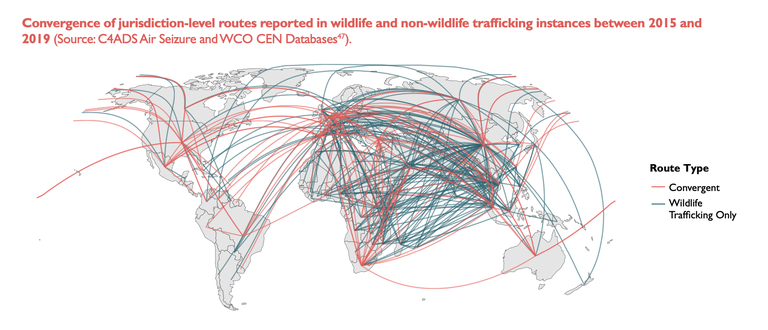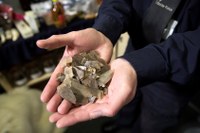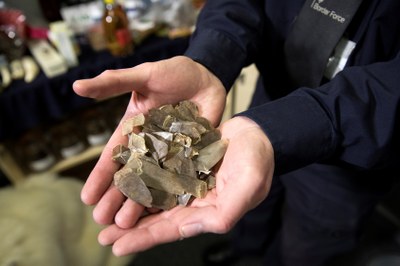Shared Skies: Insights from wildlife trafficking in air transport can help address other forms of smuggling
Mar 18, 2021
An assessment of the routes, networks and methods used for trafficking wildlife and other illicit goods such as drugs and weapons between 2015-2019 has evidenced a high degree of interconnection, which could prove fundamental to disrupting illicit activities.
The findings are detailed in the newly published brief, Shared Skies: Convergence of wildlife trafficking with other illicit activities in the aviation industry, produced by the Center for Advanced Defense Studies (C4ADS) as part of the USAID Reducing Opportunities for Unlawful Transport of Endangered Species (ROUTES) Partnership. It draws upon case studies of illicit convergence (which the report defines as the coincidence of multiple types of trafficking activities) and, crucially, advises on how this information can be leveraged to disrupt criminal activities and stop trafficking of various kinds in its tracks.
Shared skies identifies five levels at which convergence of illicit trades may occur: within the same shipment, coordinated by the same organization, using the same routes, passing through the same hub (such as a city or airport) or travelling through the same jurisdiction.
The authors underline that criminals operating in different or numerous black markets rely upon the same vulnerabilities in finance, communications and transportation systems, and further exploration of these links will better equip aviation companies and authorities to disrupt transnational crime as a whole.
"Data on the convergence of illicit activity at each level can be leveraged to shed light on transnational trafficking operations,” says Ben Spevack, lead author and Senior Analyst at C4ADS. “Improved sharing of convergence data amongst counter-trafficking stakeholders would increase collective capacity to secure the aviation industry from illicit activity.”
Using data on trafficking through aviation specifically, the report found a high rate of convergence between wildlife and other forms of illicit trade. Two thirds of cities that reported wildlife trafficking between 2015-2019 were also linked to other types of trafficking, and the majority of jurisdictions exploited by non-wildlife trafficking also appeared in wildlife seizure data.

“The findings indicate that wildlife trafficking should be treated as an integral part of the bigger picture of transnational crime,” says Michelle Owen, ROUTES lead. “Approaching the issue in singularity inhibits counter-trafficking efforts across the whole spectrum of illicit trades, all of which threaten national security, human well-being and contribute towards corruption.”
The five-level framework helps outline the unique trends and vulnerabilities that each convergence level offers and gives recommendations on how this information can be applied. For example, emergence of a convergent trafficking hub may warrant more staff training there, improved scanning technology or removal of an insider threat. Organization-level convergence can be scrutinized to understand specific networks’ modi operandi or identify corrupt individuals.
“Making anti-wildlife trafficking efforts part of protocol can bolster other counter-trafficking efforts in many ways, and vice versa,” Owen continues. “For instance, training aviation staff to recognise and report a wildlife trafficking attempt can result in seizures of other contraband: perhaps within the same shipment, or perhaps by uncovering an organization that deals in other illicit trades too.”
The brief stresses the importance of a holistic approach to addressing illicit activities and the exploitation of licit systems. It urges customs and other enforcement authorities to increase their public reporting and accessibility to seizure data in order to build a more complete picture of transnational crime, identify more trends and direct mitigation efforts where most needed. It also calls for increased collaboration across law enforcement and the private sector to identify criminal convergence and for the development of mitigation strategies that address all commodity types.
View the full brief at: https://routespartnership.org/industry-resources/publications/sharedskies/view
An interactive database of wildlife seizures in air transport can be found at: http://www.routesdashboard.org/
Contact:
Cressida Stevens, TRAFFIC Communications Support Officer
cressida.stevens@traffic.org
###
About ROUTES
The USAID Reducing Opportunities for Unlawful Transport of Endangered Species (ROUTES) Partnership brings together government agencies, transportation and logistics industry companies and representatives, international conservation, development and law enforcement organizations and donors in order to disrupt wildlife trafficking activities, and forms a key element of the concerted international response to addressing wildlife poaching and associated criminal activities worldwide.
At the heart of ROUTES is a core group of partners collaborating with the U.S. Government and the transport sector that includes Airports Council International (ACI) the Center for Advanced Defense Studies (C4ADS), the International Air Transport Association (IATA), TRAFFIC and WWF. The Partnership is funded by USAID and coordinated by TRAFFIC. To learn more, visit routespartnership.org or follow @ROUTESPartners
About USAID
The United States Agency for International Development (USAID) is responsible for the majority of overseas development assistance from the United States Government and leads international development and humanitarian efforts to save lives, reduce poverty, strengthen democratic governance and help people on their journey to self-reliance. For more information please visit usaid.gov or follow @USAID on Facebook and Twitter.
About C4ADS
C4ADS is a nonprofit organization dedicated to providing data-driven analysis and evidence-based reporting on global conflict and transnational security issues. We use cutting-edge technologies to manage, integrate, and analyze disparate data from diverse languages, regions, and sources, incorporating our own field research from conflict zones and fragile states. We seek to engage with local and international audiences and produce compelling analysis on conflict and security issues. In doing so, we fill a critical gap left by traditional public sector and profit-driven institutions. For more information, visit c4ads.org or follow @C4ADS


